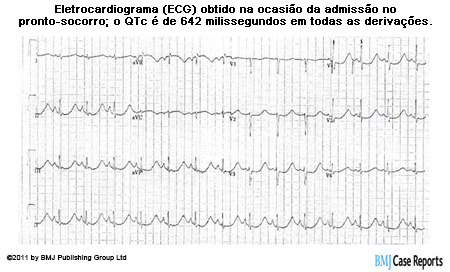Resumo
Definição
História e exame físico
Principais fatores diagnósticos
- presença de fatores de risco
- episódios recorrentes de compulsão alimentar
- comportamento compensatório inadequado recorrente
- transtorno alimentar não exclusivamente nos períodos de anorexia nervosa
- depressão e baixa autoestima
- preocupação sobre peso e forma corporal
- erosão dentária
- hipertrofia da parótida
- sinal de Russell
- arritmia
Outros fatores diagnósticos
- idade entre 20 e 35 anos
- irregularidade menstrual
- comportamento de dependência de drogas
- uso indevido deliberado de insulina
- comportamento autolesivo
- sintomas gastrointestinais
- história de fazer dietas
- flutuações acentuadas no peso
- comportamento de roubo de itens de lojas
- uso de ipeca
- marcas de agulha na pele
- vômitos na gestação
Fatores de risco
- sexo feminino
- transtorno de personalidade
- insatisfação com a imagem corporal
- história de abuso sexual
- impulsividade
- história familiar de alcoolismo
- história familiar de depressão
- história familiar de transtorno alimentar
- sobrepeso ou obesidade na infância
- exposição à pressão da mídia
- início precoce da puberdade
- urbanização
- história familiar de obesidade
- participação em esportes de elite
Investigações diagnósticas
Primeiras investigações a serem solicitadas
- eletrólitos séricos
- creatinina sérica
- magnésio sérico
- teste de gravidez na urina
- testes séricos da função hepática
- creatina quinase (CK) sérica
- Hemograma completo
- urinálise
Investigações a serem consideradas
- eletrocardiograma (ECG)
- ferritina sérica
- vitamina B12 sérica
- folato eritrocitário sérico
- absorciometria por dupla emissão de raios X para densidade óssea
Algoritmo de tratamento
adultos não gestantes
crianças e adolescentes
gestante
Colaboradores
Autores
Debra L. Safer, MD
Associate Professor
Co-Director of Stanford Eating and Weight Disorders Program
Stanford University School of Medicine
Department of Psychiatry & Behavioral Sciences
Stanford
CA
Declarações
DLS is an author of a reference cited in this topic, and receives royalties from Guilford Press for books on adapting dialectical behaviour therapy for eating disorders.
Agradecimentos
Dr Debra L. Safer would like to gratefully acknowledge Dr David C.W. Lau and Dr C. Laird Birmingham, the previous contributors to this topic.
Declarações
DCWL declares that he has no competing interests. CLB is an author of several references cited in this topic.
Revisores
Mimi Israel, MD, FRCPC
Chair of Psychiatry
McGill University
Quebec
Canada
Declarações
MI declares that she has no competing interests.
Joel Yager, MD
Professor
Department of Psychiatry
University of New Mexico School of Medicine
Albuquerque
NM
Declarações
JY is an author of a reference cited in this topic.
Créditos aos pareceristas
Os tópicos do BMJ Best Practice são constantemente atualizados, seguindo os desenvolvimentos das evidências e das diretrizes. Os pareceristas aqui listados revisaram o conteúdo pelo menos uma vez durante a história do tópico.
Declarações
As afiliações e declarações dos pareceristas referem--se ao momento da revisão.
Referências
Principais artigos
American Psychiatric Association. Diagnostic and statistical manual of mental disorders, 5th ed., text revision (DSM-5-TR). Washington, DC: American Psychiatric Publishing; 2022.
Academy for Eating Disorders. Eating disorders: critical points for early recognition and medical risk management in the care of individuals with eating disorders. 2021 [internet publication].Texto completo
Lock J, La Via MC, American Academy of Child and Adolescent Psychiatry (AACAP) Committee on Quality Issues (CQI). Practice parameter for the assessment and treatment of children and adolescents with eating disorders. J Am Acad Child Adolesc Psychiatry. 2015 May;54(5):412-25.Texto completo Resumo
Carl RL, Johnson MD, Martin TJ; Council on Sports Medicine and Fitness. Promotion of healthy weight-control practices in young athletes. Pediatrics. 2017 Sep;140(3): e20171871.Texto completo Resumo
Morgan JF, Reid F, Lacey JH. The SCOFF questionnaire: assessment of a new screening tool for eating disorders. BMJ. 1999 Dec 4;319(7223):1467-8.Texto completo Resumo
National Institute for Health and Care Excellence. Eating disorders: recognition and treatment. 16 December 2020 [internet publication].Texto completo
Artigos de referência
Uma lista completa das fontes referenciadas neste tópico está disponível para os usuários com acesso total ao BMJ Best Practice.

Diagnósticos diferenciais
- Outros transtornos alimentares ou nutricionais específicos ou transtornos alimentares ou nutricionais inespecíficos
- Anorexia nervosa, subtipo da compulsão alimentar/purgativo
- Transtorno da compulsão alimentar periódica
Mais Diagnósticos diferenciaisDiretrizes
- Practice guideline for the treatment of patients with eating disorders
- Eating disorders: recognition and treatment
Mais DiretrizesFolhetos informativos para os pacientes
Anorexia: perguntas a fazer ao seu médico
Depressão em crianças e adolescentes: perguntas para fazer ao seu médico
Mais Folhetos informativos para os pacientesConectar-se ou assinar para acessar todo o BMJ Best Practice
O uso deste conteúdo está sujeito ao nosso aviso legal